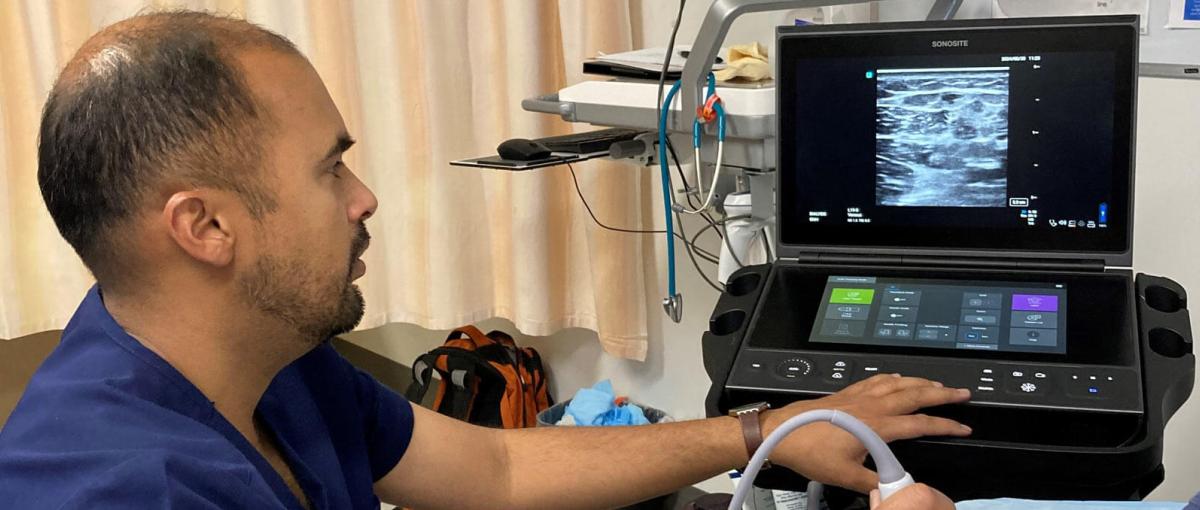Grey Nuns hospital is a leader in helping patients receive hemodialysis

September 5, 2024
By Marguerite Watson, senior communications advisor
Three times a week, for four hours at a time, Paul Albert receives hemodialysis. He has kidney failure, and hemodialysis does the work his kidneys can no longer do cleaning wastes and fluid from his blood.
To help Paul receive hemodialysis, vascular surgeons at the Grey Nuns Community Hospital created a fistula — an access, or entrance, into his blood vessels — by joining an artery and vein under the skin in his left arm. Two needles inserted into the fistula connect him to the dialysis machine. One needle removes blood and sends it to the machine, where it is filtered, and the second needle returns blood to his body.
“Because of the extra flow I am getting from the artery, my body is able to handle the dialysis treatment,” says Paul, 52, who had 12 per cent kidney function and was suffering symptoms such as water retention, exhaustion, lack of energy and urine problems. His fistula was created after he’d had emergency surgery to remove the excess water from his body and had been receiving dialysis through a tunneled catheter (a special type of intravenous line) inserted in his chest for six months.
The results of Paul’s vascular access procedure have become part of the Vascular Quality Initiative, or VQI, an international effort — involving over 1,000 medical centres — to improve outcomes for hemodialysis patients by tracking vascular surgeries. The vascular surgery team at the Grey Nuns hospital has been participating in the VQI since 2016, and from the beginning, it has recorded results that are well above the best practice for these procedures compared to other medical centres.
Typically, patients who come to the hospital for hemodialysis access are at some stage of chronic kidney disease or are already receiving hemodialysis through an intravenous line and need to have a fistula created, says Sandra Jones, a vascular access nurse at the Grey Nuns. In addition to creating access through a fistula or catheter, such as in Paul’s case, surgeons may make a connection through a synthetic graft, or soft tube.
One of the markers of quality in vascular surgery tracked in the VQI is the use of fistulas. Creating access through a fistula is preferred because it doesn’t introduce foreign objects into the body, says Dr. Yaasin Abdulrehman, the surgeon lead for vascular quality improvement at the Grey Nuns. Fistulas are also the “gold standard” for hemodialysis access because they tend to last longer and are less likely to cause complications such as infections or repeat interventions or need to be removed.
Over the last year, the Grey Nuns team was able to create hemodialysis access using fistulas versus grafts in 95.1 per cent of cases, recording results well above the average (75 per cent) for the standard of care in the VQI, says Pam Dawe, VQI data co-ordinator.
The team has also consistently achieved low complication rates following surgery, another measure of quality tracked in the VQI. In the last year, it recorded zero complications — zero bleeding, excessive swelling or other outcomes — that would require patients to be admitted to the hospital.
“That's compared to 1.4 per cent for the rest of the United States,” says Pam.
"Having zero complications is a pretty amazing statistic to stand behind. It says volumes for our team."
Vascular Quality Initiative data co-ordinator, Grey Nuns Community Hospital
In addition, the team has recorded above-average results for using vein mapping through ultrasound in creating hemodialysis access. Over the last year, it used vein mapping in 99.2 per cent of cases versus 87.9 per cent of cases recorded by other participating medical centres. Another quality standard, vein mapping involves measuring a patient’s veins to determine the type of hemodialysis access that can be created and where to place it. If the veins are large enough, a fistula can be made.
Achieving above-average vein mapping results is important because the team pushes for a “fistula first program,” says Sandra. “We always try to steer patients towards a fistula creation. It gives the patient a better-quality dialysis.”
Along with having a lower chance of infection, patients who receive hemodialysis through a fistula have more freedom and don’t need to change their lifestyle as much as those who receive hemodialysis through a graft or catheter, Sandra says. For example, they can take baths, shower and swim.
The team used vein mapping to determine the best place to create hemodialysis access for Paul, who says finding that his veins were “nice and straight” allowed them to ensure he could get good blood flow in his treatment.
Ultimately, participating in the VQI means better outcomes for patients. “It highlights to healthcare providers what quality parameters are important and also allows for collaboration in looking at ways we can improve the work we’re doing,” says Dr. Abdulrehman.
That’s good news for patients like Paul. Thanks to the fistula created in his arm, he can carry out his daily activities and live a full life.
“I feel like I can live my life better (than with the intravenous line) because I don’t have a tube sticking out of my chest,” he says. “When I had that tube, I was not allowed to get submerged in water because it would leak. I would end up with water inside my chest, crushing my lungs. (With the fistula) I do have to worry about crushing forces on my arm, but that is not as big a concern as I thought it would be.”
Paul also feels he has recovered the joy in his life that he had lost before receiving dialysis due to the exhaustion and lack of energy he experienced. “I feel much better, and being able to go around and do things and have a full day has really changed my outlook,” he says.